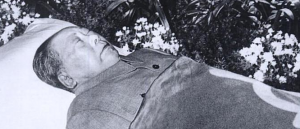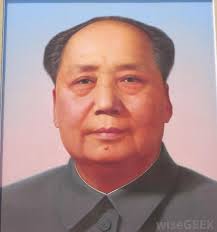China off the beaten track Part 2: Chairman Mao’s body – Tiananmen Square, Beijing

Archive image of Chairman Mao’s embalmed body, no pictures are allowed for visitors.
It’s no exaggeration to say that this is the most striking thing I’ve ever seen. (…and well worth a painful 5:40am alarm) It really is a ‘must do’ in China.
It’s beyond doubt the best ‘snap shot’ to be found of the cultural and personal impact Mao had, and still has, even after his death.
Although Chairman Mao had expressed a wish to be cremated, after his death his body was embalmed and stored in a specially constructed ‘mausoleum’ in the middle of Tiananmen Square in China’s capital.
Important warning – always check the opening times in advance. I made one painful early morning start to the mausoleum only to find it was closed, “because it’s Monday.” Pride swallowed, alarm re set, I set off the following day for a second (more successful) attempt.
There’s something blissful about the quiet, empty tube at 6am. It’s nice to watch Beijing slowly wake up to another ‘manic’ day. By half past six I was at the square and the only Westerner in the queue, which started small but built up at an astonishing rate.
It goes without saying that security is paramount at the site. I’d been warned that bags and cameras were strictly prohibited, so avoided the lengthy process of renting a locker by stuffing the pockets of my shorts with everything I’d need (including a cereal bar for later).
Once the gates opened at eight, the queue moved satisfyingly quickly. By half past eight my passport had been checked and I’d been allowed to move forward to climb the grey white marble steps into the mausoleum, surrounded by guards.
Buckets of yellow flowers line the final stint of the queue, available for those who want to leave a mark of respect for Mao. The first sight that greets you when you enter the grand building is the display of flowers; hundreds of flower pots, extravagant bouquets and single yellow blossoms sit at the feet of a white marble statue of Mao sitting an armchair. A detailed painting of ancient Chinese mountains fills the long wall behind, adding to this spectacular scene.
The queue forks around so you are forced into single file and then a snaking corridor leads you into the room where Mao lies. It’s a strictly silent zone, but there’s a hum of excitement and anticipation as people shuffle to be on the right side of each three person thick row, desperately trying to be the closest to Mao.
After walking through the dimly lit corridor and into the main room, it’s hard to register that the carefully lit body directly in front of you is real. You don’t have long to linger, stern looking guards nudge the visitors along and you are not allowed to stop, you are only allowed to walk past. My line actually got told off for walking too slowly.
Chairman Mao is behind glass with the Chinese flag draped over his body, reaching right up to his upper arms, leaving only his head and shoulders exposed. He does look a little waxy, but overall he just looks like he’s sleeping. Some say the body is a wax model, but I believe he’s the real thing.
Friends who’ve been tell me of inconsolable Chinese visitors in floods of tears. I didn’t see anything like that, but I did see a lot of people trying very hard to put on a brave face. His power and prominence is strikingly evident, even after death.
Just like that, it was over. I was in the building for less than five minutes and then I was out. Immediately outside the exit stand booths selling every kind of Mao merchandise possible from dream catchers to t-shirts and jewellery. By this time it was around 8:20am and the queue had tripled compared to when I had turned up, blurry eyed, a few hours earlier. However, the whole experience, though short and sweet, was definitely worth the early start and is not to be missed.
By Helena Sykes, summer teacher in Haining, 2013


Leave A Comment
You must be logged in to post a comment.